Reference no: EM132828692
Geotechnical Engineering Application and Theory Assignment - Leeds Beckett University, UK
Attempt ALL questions from section A PLUS TWO questions from Section B.
Section A -
Q1. Complete the following statements (write the missing words in your answer booklet):
i. Lines drawn on a bedding surface which connect points of equal height above ordnance datum are called ............ lines.
ii. The dip of a bed must be given in terms of both ................. and ................
iii. A fold is formed when rocks.......................
iv. An outcrop of young rock surrounded by older rocks is called an...............
v. The way some minerals split along flat smooth surfaces is called..................
vi. The softest mineral is .......... and the hardest is ..................
vii. The three types of metamorphism are: ..................
viii. The constant head permeability test is suitable for ............ and the falling head permeability test is suitable for............
ix. The two common laboratory tests to determine the shear strength of soils are ........... and ............
x. The two parameters of shear strength are...........and...........
Q2. You have been given (in the plastic bag) a collection of rock/mineral samples:
i) Identify the name and type of each sample.
ii) Concisely describe the sample's properties.
Q3. Groundwater in soil may be one of two types, occurring in two distinct zones - define these zones with the aid of a sketch.
Q4. i) Define coefficient of permeability in the context of groundwater flow.
ii) State Darcy's equation and define each term, include units.
iii) With the aid of a sketch derive, from first principles, the falling head equation.
iv) During a constant head permeability test the following data was recorded for a sample of soil having a diameter 75 mm. Determine the average value of the coefficient permeability 'k'.
|
Flow quantity for 2 minutes (ml)
|
1009
|
942
|
757
|
606
|
474
|
|
Difference in manometer levels (mm)
|
82
|
75
|
62
|
50
|
38
|
Distance between manometer tapping points = 120 mm.
Length of flow path = 120 mm.
Q5. A pumping test was carried out to determine the permeability of a sand layer in an unconfined aquifer with a well arrangement as shown below. At steady-state pumping rate of 42.2 m3/h, the draw downs in the observation wells were respectively 5.71 m and 2.45 m. Calculate the coefficient of permeability, k.
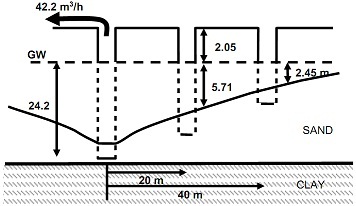
Q6. The following results were recorded during a shear box test on a soil:
|
Normal load (kg)
|
10
|
20
|
30
|
40
|
|
Shear load at failure (N)
|
82
|
125
|
195
|
228
|
If the specimen size was 60 mm x 60 mm, plot the failure envelope and determine the shear stress parameters.
Q7. Determine the un-drained shear strength of a clay sample tested by the unconsolidated un-drained tri-axial test, given the following:
|
Cell Pressure kN/m2
|
Proving Ring Dial (Div)
|
Vertical Deformation (mm)
|
|
200
|
165
|
7.12
|
|
400
|
163
|
9.42
|
|
600
|
168
|
10.11
|
Diameter of sample = 38 mm; Length of sample 76 mm; Proving ring constant = 1.3 N/Div; Area = A0/(1- ε).
Section B -
Q1. For Figure 1:
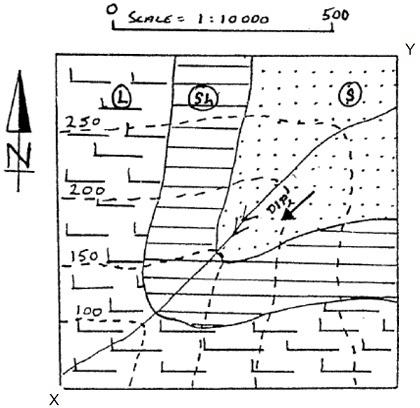
i) Draw the strike lines for each bed.
ii) Determine the direction and angle of dip.
iii) Draw a scale cross-section (on graph paper) between points X and Y to show the ground surface and the direction of the dipping strata.
For Figure 2:
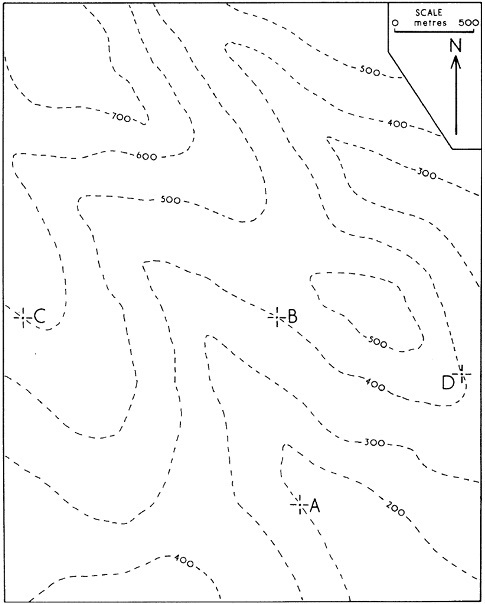
iv) Deduce the direction and angle of dip of the coal seam which is seen to outcrop at points A, B and C.
v) At what depth would the coal seam be encountered in a borehole sunk at point D?
vi) Complete the outcrop of the seam.
Q2. i) Calculate the vertical stress, σv, at 4m below the point 'A' shown below on the loaded area using Bousinesq 'point load' solution.
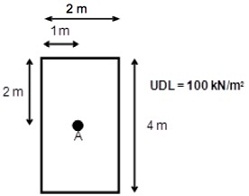
ii) Calculate the vertical stress, σv, at 3 m below the points 'A', 'B' and 'C' shown below on the loaded area using Fadum's graphical solution.
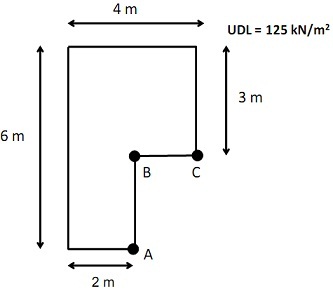
iii) Calculate the immediate settlement beneath the centre of the spread foundation shown below (assume Eu = 8 MN/m2).
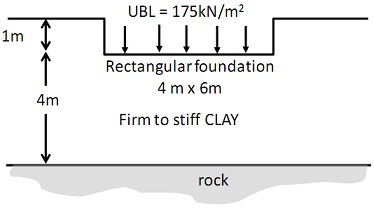
iv) Calculate the consolidation settlement of the layer of soft silty CLAY beneath the 2 m square foundation shown below.
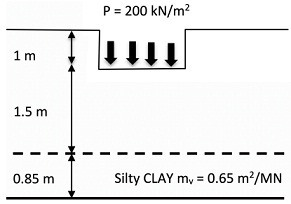
Q3. i) List three advantages and three disadvantages of the following pile types:
Precast driven piles
In-situ replacement piles
ii) A site is underlain by cohesive soil, which has a cohesion of 50 kN/m2 at ground level, increasing to 150 kN/m2 at 10 m depth. For a single 0.3 m diameter bored pile constructed to 7 m depth (assume γconc = 25 kN/m3):
a) Determine the design actions (Fc;d) for the following loads:
Permanent = 75 kN
Variable = 10 kN
b) Calculate the design resistance (Rc;d).
c) Determine the degree of utilisation, hence suitability.
d) Comment on your findings.
Use EC7 UK-NA partial factors, DA1, also the design is based on calculations without confirmation tests (i.e. no SLS) and model factor must be included.